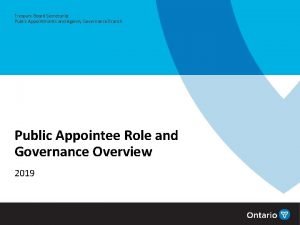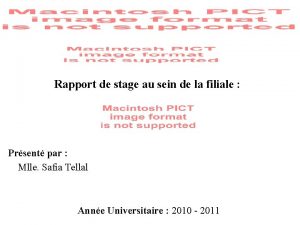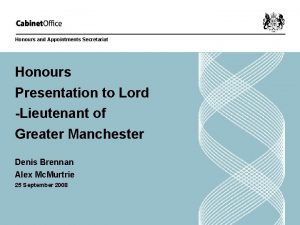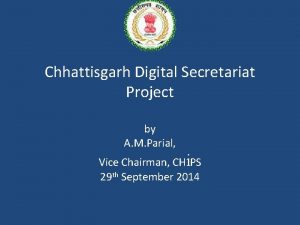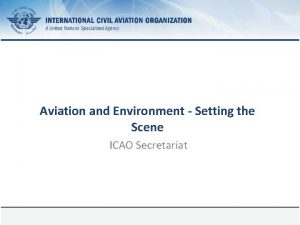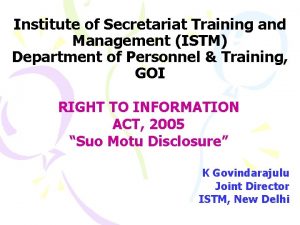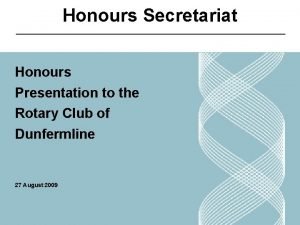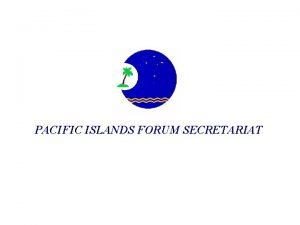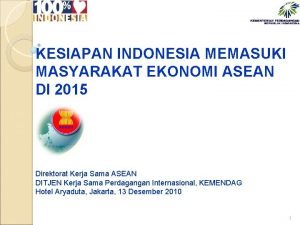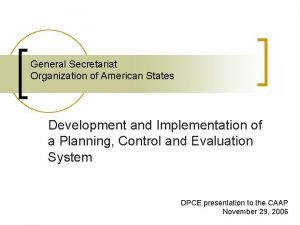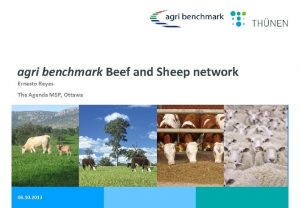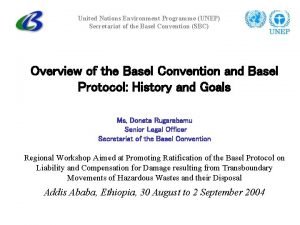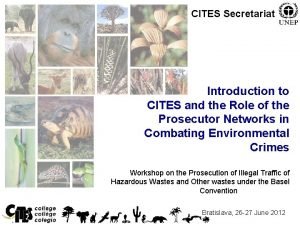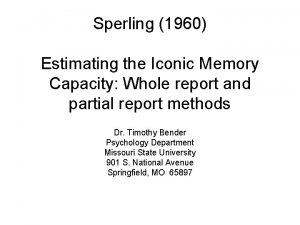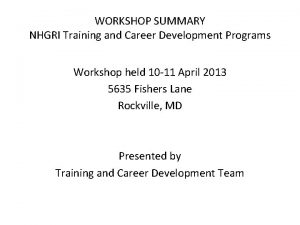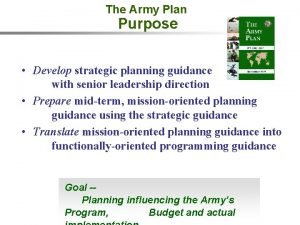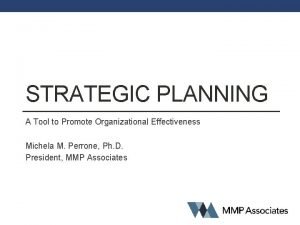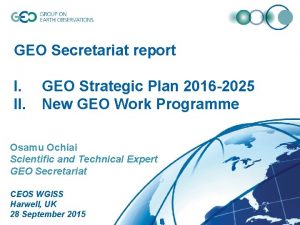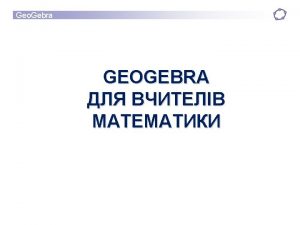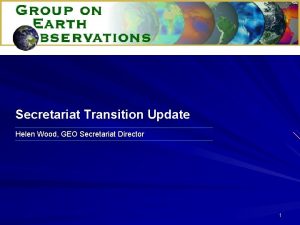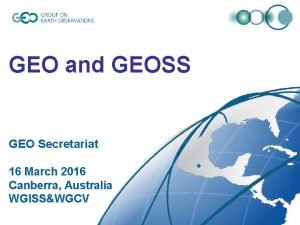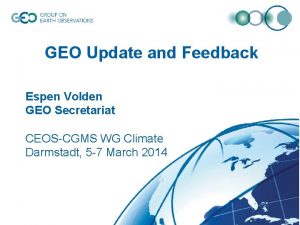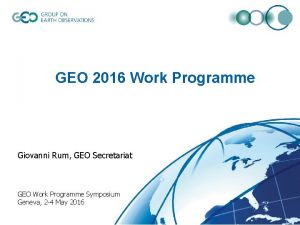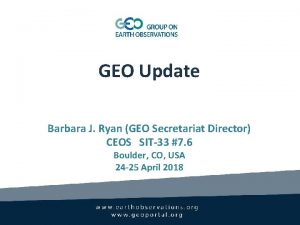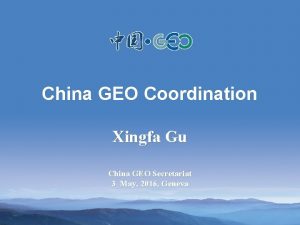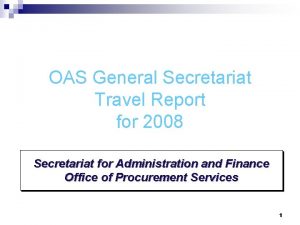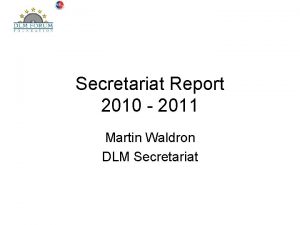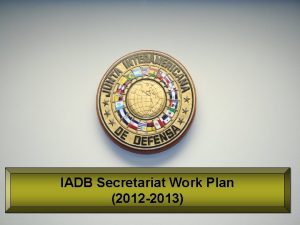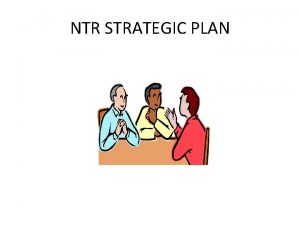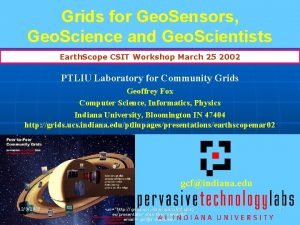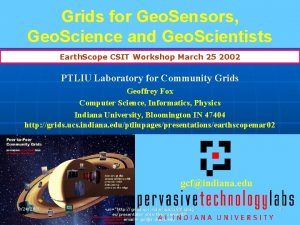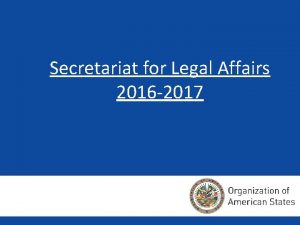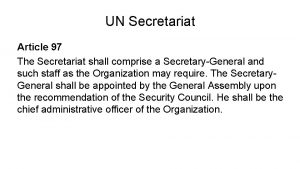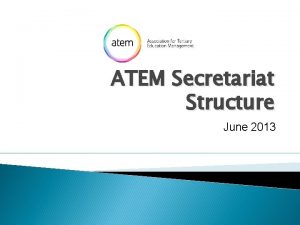GEO Secretariat report I II GEO Strategic Plan

























- Slides: 25

GEO Secretariat report I. II. GEO Strategic Plan 2016 -2025 New GEO Work Programme Osamu Ochiai Scientific and Technical Expert GEO Secretariat CEOS WGISS Harwell, UK 28 September 2015

I. GEO Strategic Plan 2016 -2025 based on a presentation by Toshio Koike (IPWG Member)

Strategic Plan 2016 -2025: Implementing GEOSS Part A: Strategy Reference Document Part B: Implementation • • V 2. 2 has been issued in July GEOSS Description GEOSS Data Sharing Principles GEOSS Data Management Principles Core Functions Implementation Mechanisms GEO Work Programme Development • Next version to be circulated by 29 September

Part A: Strategy • Vison for GEO - to envision a future wherein decisions and actions for the benefit of humankind are informed by coordinated, comprehensive and sustained Earth observations. • GEO’s Mission - to connect the demand of decision-makers with the supply of data and information - to unlock the power of Earth observations • GEO’s Value Convening Power - to assemble and coordinate expertise from across different disciplines and communities

Part A: Strategy Societal Benefit Areas • • Biodiversity and Ecosystem Sustainability Disaster Resilience Energy and Mineral Resources Management Food Security and Sustainable Agriculture Infrastructure and Transportation Management Public Health Surveillance Sustainable Urban Development Water Resources Management Climate change and its impacts, are crosscutting and connect with several the SBAs.

Part B: Implementation To implement the Strategy identified in Part A, GEO will leverage the successes of its first decade. GEO has: • advanced international sharing and interoperability; • fostered substantial collaboration by creating new global initiatives and supporting vital regional initiatives; • advanced new Earth observation efforts by creating new, user-driven networks and projects.

Part B: Implementation To implement the Strategy identified in Part A, GEO will leverage the successes of its first decade. GEO will implement Data Sharing Principles: - by making data, metadata and products available as part of the GEOSS Data-CORE without charge or restrictions on reuse; - by making metadata, data and products available with minimal restrictions on use and at no more than the cost of reproduction and distribution; - by making metadata, data and products available with minimum time delay. GEO will implement Data Management Principles: - by focusing on discoverability, accessibility, usability, preservation and curation.

Part B: Implementation Core Functions 1. Identifying user needs and addressing gaps in the information chain 2. Sustaining foundational observations and data 3. Fostering partnerships and mobilize resources 4. Advancing GEOSS and best practice in data management and sharing 5. Implementing sustained global and regional services 6. Cultivating awareness, building capacity and promoting innovation § Essential for realization of Strategic Objectives § Accompanied by specific, measurable and achievable targets

Part B: Implementation Mechanisms

II. GEO Work Programme

Introduction on Work Programme • The GEO 2016 transitional Work Programme is the first of the new GEO decade 2016 -2025. • It is being developed in parallel with the new Strategic Plan in order to have the necessary tool in place to ensure continuity to GEO actions in 2016. • It bridges the first and the second GEO decades, it ensures continuation of current activities and inclusion of new ones.

Introduction on Work Programme Transitional Work Programme 2016 • Its development is coordinated by the GEO Secretariat in consultation with the GEO IPWG under the guidance of the GEO Executive Committee during 2015. “Regular” 3 -year Programmes 2017 -19, 2020 -22 and 2023 -25 • The Work Programme is drafted by the GEO Secretariat based on inputs from GEO Members, Participating Organizations, and the GEO Community at large. • Through an iterative process, it is reviewed and further developed by the GEO Programme Board, which ensures alignment with the priorities of GEO Members and Participating Organizations, identifies resource commitments by GEO Members and Participating Organizations, and recommends it to GEO Plenary for approval.

Activities total number Community Activities GEO Initiatives Foundational Tasks TOTAL 33 20 18 71 ALL Current Societal Benefit Areas are addressed

Community Activities - Current List (1) CA-01 CA-02 CA-03 CA-04 CA-05 CA-06 CA-07 CA-08 CA-09 CA-10 CA-11 CA-12 CA-13 CA-14 CA-15 CA-16 CA-17 Global Land Cover for Africa Access to model data in GEOSS Strengthen collaboration between GEO and GFCS TIGGE (Thorpex Interactive Grand global Ensemble) evolution into a Global Interactive Forecast System (GIFS) EO data and mineral resources (Includes also the, Impact Monitoring System for Geo. Resource Exploration and Exploitation) Integrated Water-cycle Products and Services - Overall coordination Water Vapor and Clouds (and Aerosol and Precipitation) Precipitation Evapotranspiration (and Evaporation) Soil Moisture River Discharge Groundwater GEO Water Quality Water Cycle Capacity Building Global Drought Information System (GDIS) GEO Great Lakes Activity

Community Activities - Current List (2) CA-18 CA-19 CA-20 CA-21 CA-22 CA-23 CA-24 CA-25 CA-26 CA-27 CA. 28 CA. 29 CA-30 CA-31 CA-32 CA-33 Water Cycle Integrator (WCI) E 2 E Water Indicators Eart. H 2 Observe Total Water Prediction: Observations Infrastructure (new-US) Linking water tasks with wider societal benefit areas and the post-2015 global development framework Space and Security Earth Observation in Cultural Heritage documentation Africa Global-scale Geochemical Baselines for mineral resource and environmental management: Capacity-building phase Towards Chinese tsunami mitigation system under GEO framework Foster Utilization of Earth Observation Remote Sensing and In Situ Data for All Phases of Disaster Risk Management (new-CEOS) Global Flood Risk Monitoring (new-US) Using Geospatial Data to Identify and Monitor Ecosystem Service and Track in a Natural Capital – Ecosystems Accounts Framework (new-US) Harmful Algal Bloom (HAB) Early Warning System (new-US) For Global Mangrove Monitoring (new-US) Research Data Science Summer Schools (new-CODATA/RDA) Building capacity for Forest Biodiversity in Asia and the Pacific Region (new. Indian Institutions)

GEO Initiatives – current List GI-01* GI-02* GI-03* GI-04* GI-05* GI-06 GI-07 GI-08 GI-09 GI-10 GI-11 GI-12 GI-13 GI-14 GI-15 GI-16 GI-17 a GI-17 b GI-18 GI-19 GI-20 GEOGLAM-Global Agricultural Monitoring and Early Warning GEOBON-Global Biodiversity Observation (GEO BON) GFOI Global Forest Observation Initiative Global Observing System for Mercury and Persistent Pollutants Global Carbon Observation and Analysis System Reinforcing engagement at regional level: Afri. GEOSS for Africa Ocean and society - Blue Planet GEO Geohazard Supersites and Natural Laboratories (GSNL) Global Wildfire Information System EO data and renewable energies Information Services for Cold Regions Integrated Information Systems for Health (Cholera, Heat waves) Integration of Methods for Air Quality and Health Data, Remote Sensed and In-Situ with Disease Estimate Techniques (new US) GECO: the GEO Global Ecosystem Initiative GEO-GNOME Initiative: GEO Global Network for Observation and information in Mountain Environments GEO-DARMA = Data Access for Risk Management (new-CEOS) Global Urban Observation and Information Global Human Settlement indicators for post-2015 international frameworks GEO and SDGs. EOs role in providing support to countries in achieving SDGs and in defining and monitoring the associated indicators. Ameri. GEOSS (new) GEO Global Water Security (GEOGLOWS) new-US * Proposed as GEO Flagship

Foundational Tasks – current List GD GD-01 GD-02 GD-03 GD-04 GD-05 GD-06 GD-07 GD-08 GD-09 GD-10 GD-11 CD CD-01 CD-02 CD-03 SO SO-01 SO-02 SO-03 SO-04 GEOSS Development and GCI Operations Advancing GEOSS Data Sharing principles GCI Operations (including access to Knowledge) Global Observing and Information Systems (new) (includes systems like WIGOS. GCOS; …. And reference datasets) GEONETCast Development and Operations GEOSS satellite Earth Observation Resources (includes advocacy for continuity) GEOSS non-space based Observation Resources (includes inclusion of citizens’ observatories) (includes advocacy for continuity) GCI Development (includes development of Data Management guidelines) SBAs processes: Systematic determination of user needs / observational gaps Knowledge Base development Radio-frequency protection Utilization of Communication Networks Community Development Capacity Building coordination Reinforcing engagement at national and regional level Assess the benefits from EOs and of their socio-economic value Secretariat Operations Management and Support Communication and Engagement Monitoring and Evaluation Resources Mobilization

GD 3: Global Observing and Information Systems (includes systems like WIGOS. GCOS; …. And reference datasets) 1. General description The GEOSS as a ‘system of systems’ will proactively link together existing and planned observing and information systems around the world, foster interoperability, and support the development of new systems where gaps currently exist. In this regards, the task will provide various coordination opportunities in order to advocate new systems, to strengthen existing and planned systems and also to encourage integrating and linking different systems. 2. Implementation approach, respective responsibilities The task will be coordinated by the Secretariat. a. Contributors (WMO, GCOS, GEO members) i. Improve integration different Observation systems by defining metadata of Observation systems contributing to GEOSS (e. g. , WIGOS, GCOS, GOOS, GGOS) ii. Sustain and improve existing operational Information systems contributing to GEOSS (e. g. , WMO Information System (WIS), One. Geology, IRIS) iii. Make efforts to implement the GEOSS Data Sharing Principles. iv. Make efforts to ensure interoperability with GEOSS and GCI. v. Develop data model for each system, implementing the GEOSS Data Management Principles. vi. Maintain and improve the operational network diversities such as satellite based, ground based and internet.

GD 3: Global Observing and Information Systems (includes systems like WIGOS. GCOS; …. And reference datasets) GEO Secretariat i. Overarching coordination in particular to support cross linkages in different communities and to support GEOSS Data Sharing Principles, Data Management Principles and interoperability with GEOSS and GCI. ii. Inventory Global Earth observation systems iii. Identify potential gaps, duplications and synergies; 3. Planned activities and outputs for 2016 1. Resume coordination and consultations with Global Observing and Information Systems. 2. Produce a document describing GEO plans to support existing Systems and facilitate development of new ones, including their connection with GCI 3. Produce a report on “Inventory of Global Earth observation and information systems” with identifying potential gaps, duplications and synergies

GD 07: GCI Development (includes development of Data Management guidelines) 1. General description Define and maintain the GCI evolution strategy and architecture based on documented and emerging user requirements, and analysis of evolving landscape in technology and production/consumption of EO data products and services. Undertake R&D activities, in collaboration with public, private, and voluntary sectors, to develop and test new functionalities, solutions, and components needed to support the achievement of GEO Strategic Plan objectives and user needs. Develop documentation and training material needed to support transition from development to operations of identified new components and solutions. 2. Implementation approach and respective responsibilities This task will be implemented by a GEOSS Development Working Group (GDWG), which will include major contributors. The GEO Secretariat will support the GDWG and ensure that its activities are fully supportive of the current needs of the Portal and common components. a. Contributors (JRC, USGS, CNR, ESA, OGC, IEEE) i. Define and maintain of the GCI evolution Strategy and Architecture based on documented and emerging user requirements, and analysis of evolving landscape in technology and production/consumption of EO data products and service ii. Develop and test new functionalities, solutions, and components iii. Develop Data Management Guidelines and best practices iv. Implement subsequent Architecture Implementation Pilot Projects on yearly basis (AIP-9 in 2016), to test solutions and to promote the use of GEOSS data to develop products and services v. Support the advance of the GEOSS interoperability through the Standards and Interoperability Forum (SIF) vi. Engage the GEO community through guidelines and tutorials that explains the utilization of the GEOSS and the GCI. vii. Continue to develop the Community Portal Recommendations paper that provides best practices, examples and lessonslearned to promote and facilitate communities’ use of the GCI and assist them in contributing their capabilities to GEOSS.

GD 07: GCI Development (includes development of Data Management guidelines) b. GEO Secretariat i. Overarching coordination ii. GCI Requirements consolidation and update 3. Planned activities and outputs 1. Consolidate/update a document “Evolution of GCI functionalities and architecture” for GEO-XII Plenary approval 2. Develop and integrate the new functionalities to ensure access to the Knowledge base being developed. 3. Continue to improve GCI performance in response to user feedback and GEO activities needs 4. Report results on AIP - 9 5. Develop Data Management Guidelines and Best Practices 6. Finalize and publish the documentation that reflects current GCI configuration 7. Organize a GEOSS Interoperability Workshop 8. Publish new guidelines and tutorials in the Best Practices Wiki

GEO WP 2016 Development timeline September 29 Version 4. 0, as a GEO-XII Plenary document November 11 -12 GEO-XII – inputs from Delegations, including pledges on 2016 contributions to GEO trust fund (a driver to scope Foundational tasks) Version v 5 – Final (incorporating Plenary decisions) Dec 15

GEOSS Common Infrastructure

GEOSS Resources 200 000 180 000 160 000 Resources 140 000 Introduction of the Brokering approach 120 000 100 000 80 000 60 000 40 000 20 000 - Series 1 2010 300 2011 (Sep) 100 000 2011 (Nov) 1 002 000 2012 (Nov) 14 000 2014 (Apr) 71 000 2015 (July) 174 000

CWIC 70 M Granules All GEOSS Data-CORE CEOS Resources Fed. EO 82 M Granules No GEOSS Data-CORE
 Public appointments secretariat
Public appointments secretariat Premiere page du rapport de stage
Premiere page du rapport de stage Honours and appointments secretariat
Honours and appointments secretariat Cg digital secretariat
Cg digital secretariat Icao
Icao Literacy and numeracy secretariat
Literacy and numeracy secretariat Institute of secretariat training and management
Institute of secretariat training and management Honours secretariat
Honours secretariat Secretariat family tree
Secretariat family tree Pacific island forum secretariat
Pacific island forum secretariat Asean secretariat
Asean secretariat General secretariat for development planning
General secretariat for development planning Agri benchmark
Agri benchmark Unep secretariat
Unep secretariat Trans kalahari corridor secretariat
Trans kalahari corridor secretariat Cites secretariat
Cites secretariat Strategic fit vs strategic intent
Strategic fit vs strategic intent Strategic complements
Strategic complements Io model strategic management
Io model strategic management Tows matrix
Tows matrix Difference between progress report and status report
Difference between progress report and status report Sperling (1960)
Sperling (1960) Nhgri strategic plan
Nhgri strategic plan What is strategic planning
What is strategic planning Army strategic planning guidance
Army strategic planning guidance Strategic implementation plan
Strategic implementation plan
